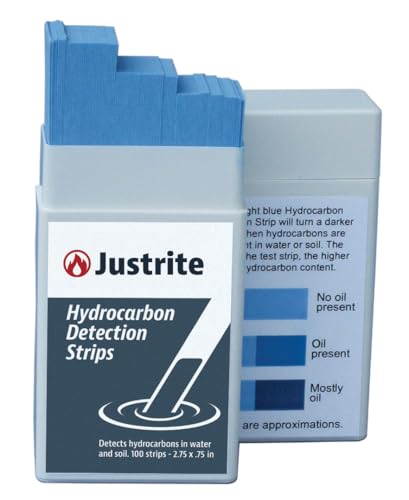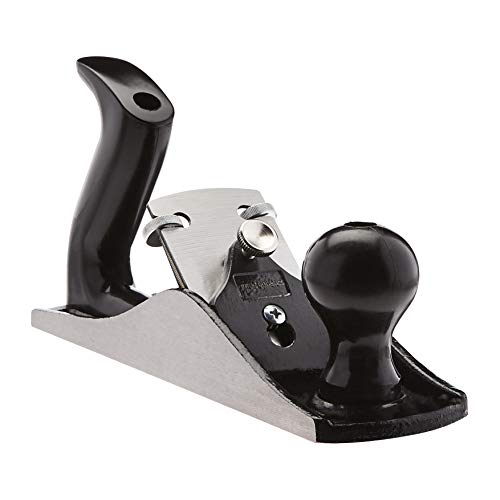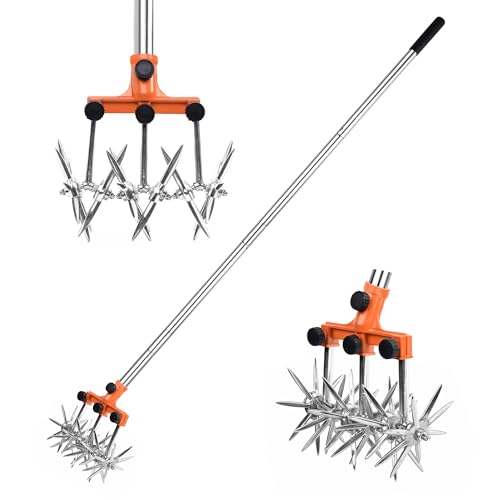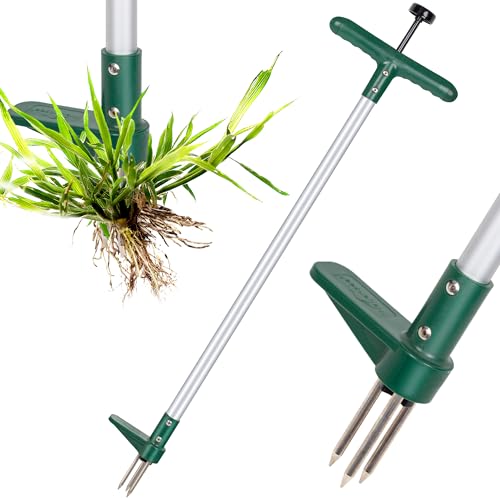Best Hydrocarbon Soil Test Kit
Ensuring soil health is paramount, particularly when hydrocarbon contamination is a concern. Whether you’re assessing a potential building site, investigating a spill, or monitoring remediation efforts, accurate soil testing is crucial.
Selecting the best hydrocarbon soil test kit is therefore a vital decision. The market offers a range of options, each promising reliable results.
However, the quality and accuracy of these kits can vary significantly, impacting the validity of your findings and subsequent actions. This article aims to guide you through the selection process, emphasizing the importance of choosing the best hydrocarbon soil test kit that balances accuracy, reliability, and value.
Investing in the right kit ensures informed decisions and safeguards both the environment and human health.
IN THIS ARTICLE
Top 10 Best Hydrocarbon Soil Test Kit Compared

🏆 BEST OVERALL Justrite Hydrocarbon Test Strips for Oil and Water
- Provides instant visual results for hydrocarbon detection.
- Aids in meeting EPA regulations for water discharge.
- Detects gasoline, fuel oil, and lubricants in water and soil.
- Comes in a durable container for easy storage and transport.
4.4/5
Check Price on Amazon

🥈 2ND RUNNER UP MySoil Soil Test Kit
- Comprehensive analysis of 13 plant-available nutrients, including Nitrogen and pH.
- Suitable for diverse growing conditions, including lawn, garden, and hydroponics.
- Provides customized organic and non-organic fertilizer recommendations.
- Includes prepaid mailing envelope for easy sample submission.
4.7/5
Check Price on Amazon

� BEST VALUE Rapitest Soil Test Kit for Gardens
- Easy-to-use capsule system and color comparators.
- Includes components for 20 tests (5 for pH, N, P, and K).
- Detailed instructions suitable for beginners.
- Provides a quick assessment of key soil nutrients.
4.7/5
Check Price on Amazon

NewTest Soil Test Kit 4 Parameters: Professional A
- Allows for at-home testing of pH, nitrogen, phosphorus, and potassium.
- Includes a generous amount of tests (40 total).
- Provides detailed and easy-to-understand instructions.
- Suitable for various soil types and gardening conditions.
4.7/5
Check Price on Amazon

7-in-one Soil Test Kit
- Measures seven different parameters: soil moisture, pH, fertility, sunlight, soil temperature, air humidity, and air temperature.
- Features an LCD display for easy reading of measurements.
- Metal probes designed for faster and more accurate readings.
- Versatile for various gardening applications.
4.5/5
Check Price on Amazon

Soil Test Kit -140 Test- 2025 Updated- Testing PH
- Offers comprehensive analysis of pH, ammonia, nitrogen, phosphorus, and potassium.
- Provides customized fertilizer recommendations.
- Claims to be time and cost-effective compared to lab testing.
- Aims to promote optimal plant health and yield.
4.5/5
Check Price on Amazon

2-in-1 pH & Nitrogen Soil Test Kit
- Easy and fast to use at home.
- Includes all necessary components (strips, tube, spoon, instructions).
- Tests both pH and nitrogen levels.
- Individually sealed packaging extends shelf life.
4.8/5
Check Price on Amazon

Soil pH Paper Test Kit – 100 Tester Strips (3.5-9
- Easy to use testing procedure.
- Cost-effective with 100 strips per package.
- Wide pH range coverage (3.5-9).
- Portable for on-the-go testing.
4.6/5
Check Price on Amazon

Whitetail Institute Laboratory Soil Test Kit
- Easy to use with all necessary materials included.
- Fast results delivered within one week.
- Results and recommendations are easy to understand.
- Potentially saves money on fertilizer and lime by optimizing application.
4.8/5
Check Price on Amazon

Mosser Lee/Soil Master ML1210 Soil Test Kit – 40 T
- Easy to understand illustrated instructions.
- Provides quick, immediate results.
- Versatile; usable for lawns, gardens, and potted plants.
- Aids in making informed planting decisions.
4.7/5
Check Price on Amazon
Detailed Reviews of the Best Hydrocarbon Soil Test Kit
Justrite Hydrocarbon Test Strips for Oil and Water – Provides instant visual results for hydrocarbon detection.

The oil tester strips offer a quick and easy method for detecting hydrocarbon contamination in various settings. The color change indicator provides immediate feedback, simplifying the monitoring process. The strips appear well-suited for identifying common contaminants like gasoline, fuel oil, and lubricants.
The included container is practical for storage and transportation, ensuring the strips remain readily accessible. With 100 strips per container, this product should provide a decent lifespan for regular monitoring needs. This product can be useful for staying compliant with EPA regulations.
However, the accuracy and sensitivity compared to laboratory testing are unknown, and the color change interpretation might be subjective in some cases. More detailed instructions on interpreting subtle color variations would be beneficial.
Pros
- Provides instant visual results for hydrocarbon detection.
- Aids in meeting EPA regulations for water discharge.
- Detects gasoline, fuel oil, and lubricants in water and soil.
- Comes in a durable container for easy storage and transport.
- Versatile use in various monitoring applications.
Cons
- Accuracy compared to lab testing is unknown.
- Color change interpretation can be subjective.
MySoil Soil Test Kit – Comprehensive analysis of 13 plant-available nutrients, including Nitrogen and pH.

This soil test kit offers a comprehensive analysis of your soil’s nutrient levels, going beyond basic pH measurements provided by at-home alternatives. The kit is designed for various growing scenarios, from lawns to hydroponics. It aims to help users understand exactly what their soil needs, preventing over-application of unnecessary products.
The promise of customized organic and non-organic fertilizer recommendations is a significant benefit. Turnaround time for results is stated to be 6-8 days. The kit includes everything needed for sample collection and mailing, making the process relatively straightforward.
Dedicated customer support is also included for assistance with interpretation of results or any issues during the testing process. However, the single-use nature of the kit means repeated testing requires purchasing additional kits.
Pros
- Comprehensive analysis of 13 plant-available nutrients, including Nitrogen and pH.
- Suitable for diverse growing conditions, including lawn, garden, and hydroponics.
- Provides customized organic and non-organic fertilizer recommendations.
- Includes prepaid mailing envelope for easy sample submission.
- Offers dedicated customer support.
- Potentially saves money by avoiding unnecessary fertilizer applications.
Cons
- Single-use kit requires repurchase for subsequent testing.
- Results take 6-8 days to receive, which may be too long for some users.
Rapitest Soil Test Kit for Gardens – Easy-to-use capsule system and color comparators.

This at-home soil test kit offers a convenient way to assess pH, Nitrogen, Phosphorus, and Potash levels in your soil. The kit includes enough materials for 20 tests, with 5 dedicated to each of the four key metrics. The capsule system and color comparators aim to simplify the testing process, making it accessible for both beginners and experienced gardeners.
The provided instructions are detailed and easy to follow, and the included soil pH preference list for over 450 plants is a useful bonus. While the kit offers a quick and inexpensive method for soil analysis, users should understand that the results are approximations and may not be as precise as professional lab testing. Overall, it provides a good starting point for understanding your soil composition and making informed decisions about fertilization and plant selection.
Pros
- Easy-to-use capsule system and color comparators.
- Includes components for 20 tests (5 for pH, N, P, and K).
- Detailed instructions suitable for beginners.
- Provides a quick assessment of key soil nutrients.
- Includes a soil pH preference list for a wide variety of plants.
Cons
- Results are approximations and may not be as accurate as professional lab tests.
- Color comparison can be subjective and influenced by lighting.
NewTest Soil Test Kit 4 Parameters: Professional A – Allows for at-home testing of pH, nitrogen, phosphorus, and potassium.

The NewTest Soil Test Kit aims to provide users with an accurate and accessible way to analyze their soil’s pH, nitrogen, phosphorus, and potassium levels at home. The kit includes materials for 10 tests each of the four parameters, totaling 40 tests. The provided instructions are designed to be comprehensive and easy to follow, even for beginners.
The results are obtained through a colorimetric comparison system, where users match the test strip or liquid color to a provided color chart to determine the nutrient level. The kit is marketed as suitable for various soil types and gardening conditions, from lawns to hydroponics. While promising accurate results outside of a lab setting, user interpretation and adherence to instructions are crucial for obtaining reliable data.
Overall, the kit appears to offer a convenient solution for home gardeners seeking to understand their soil composition.
Pros
- Allows for at-home testing of pH, nitrogen, phosphorus, and potassium.
- Includes a generous amount of tests (40 total).
- Provides detailed and easy-to-understand instructions.
- Suitable for various soil types and gardening conditions.
- Aims to provide accurate results comparable to lab tests.
Cons
- Accuracy relies heavily on user adherence to instructions and proper color comparison.
- While striving for lab-level accuracy, results may still not be as precise as professional lab analysis.
7-in-one Soil Test Kit – Measures seven different parameters: soil moisture, pH, fertility, sunlight, soil temperature, air humidity, and air temperature.

This 7-in-1 soil testing kit aims to provide a comprehensive understanding of soil and environmental conditions for gardening. It measures soil moisture, pH, fertility, sunlight, soil temperature, air humidity, and air temperature, displayed on an LCD screen. The metal probes are designed for faster and more accurate readings compared to standard materials.
It’s versatile for various planting scenarios like home gardening and greenhouses. However, the kit is not suitable for testing liquids, rocks, overly hard soil, or loose sandy soils. Proper usage, including cleaning the probes and avoiding excessive force during insertion, is crucial for accurate readings and preventing damage.
While offering a range of data points, users should be mindful of the device’s limitations in certain soil types.
Pros
- Measures seven different parameters: soil moisture, pH, fertility, sunlight, soil temperature, air humidity, and air temperature.
- Features an LCD display for easy reading of measurements.
- Metal probes designed for faster and more accurate readings.
- Versatile for various gardening applications.
Cons
- Not suitable for testing liquids, rocks, excessively hard soil, or loose sandy soils.
- Requires careful handling and cleaning of probes for accurate results and to avoid damage.
Soil Test Kit -140 Test- 2025 Updated- Testing PH – Offers comprehensive analysis of pH, ammonia, nitrogen, phosphorus, and potassium.

This liquid soil test kit provides a comprehensive analysis of key soil parameters like pH, ammonia, nitrogen, phosphorus, and potassium. The kit aims to provide insights into soil fertility and health, aiding users in making informed decisions about fertilization. It offers customized fertilizer recommendations based on the test results, designed to optimize plant growth and prevent over-fertilization.
Users can expect a relatively quick and easy testing process compared to lab submissions, delivering rapid results suitable for lawns, gardens, and various plants. While the product claims accurate and precise measurements when used correctly, user technique may influence outcome. Each parameter except nitrogen can be tested around 40 times, while nitrogen allows about 20 tests.
Pros
- Offers comprehensive analysis of pH, ammonia, nitrogen, phosphorus, and potassium.
- Provides customized fertilizer recommendations.
- Claims to be time and cost-effective compared to lab testing.
- Aims to promote optimal plant health and yield.
- Includes enough reagents for multiple tests (140 total).
Cons
- Accuracy may depend on proper user technique.
- Nitrogen test quantity is significantly lower than other parameters.
2-in-1 pH & Nitrogen Soil Test Kit – Easy and fast to use at home.

The Sooenben 2-in-1 Soil Test Kit offers a convenient way to assess soil pH and nitrogen levels at home. The kit includes everything needed for testing: strips, a test tube, a sample spoon, and instructions. The process is relatively simple, involving mixing a soil sample with water, dipping a test strip, and comparing the color to a provided chart.
The individually sealed packaging of the strips helps to maintain their shelf life. It’s versatile for various plants, from indoor flowers to vegetable gardens. While it provides a quick and easy method for soil analysis, users should adhere to the instructions carefully, particularly regarding water usage and strip orientation, to ensure accurate results.
Pros
- Easy and fast to use at home.
- Includes all necessary components (strips, tube, spoon, instructions).
- Tests both pH and nitrogen levels.
- Individually sealed packaging extends shelf life.
- Versatile for a wide range of plants and applications.
Cons
- Requires careful adherence to instructions for accurate readings (water type, strip orientation).
- Results are indicative and may not be as precise as a professional lab test.
Soil pH Paper Test Kit – 100 Tester Strips (3.5-9 – Easy to use testing procedure.

The Dewildetradingco Soil pH Test Strips offer a convenient and relatively inexpensive way to gauge the pH levels of your soil. With a range of 3.5 to 9, they cover a broad spectrum suitable for various plants. The included 100 strips provide ample testing opportunities for different areas or repeat measurements.
The testing procedure is straightforward, requiring a soil/water mixture and comparison with a color chart. While the process isn’t as precise as a digital meter, it provides a quick and easily accessible approximation of the soil’s pH level, potentially aiding in optimizing plant health and resource management. It’s a practical tool for gardeners seeking a basic understanding of their soil conditions.
Pros
- Easy to use testing procedure.
- Cost-effective with 100 strips per package.
- Wide pH range coverage (3.5-9).
- Portable for on-the-go testing.
- Helpful for general pH level understanding.
Cons
- Less precise than digital pH meters.
- Reading relies on subjective color matching.
Whitetail Institute Laboratory Soil Test Kit – Easy to use with all necessary materials included.

This soil testing kit promises a simple and cost-effective way to optimize food plots. It emphasizes ease of use, claiming to include everything needed for sample collection. The major selling point is the quick turnaround time, with results delivered within one week via mail or email.
Furthermore, the results are presented in an easily understandable format, along with specific recommendations for fertilizer and lime application. This kit is designed to potentially reduce expenses associated with soil amendment by ensuring precise application based on tested needs. The overall value will depend on the accuracy and usefulness of the recommendations provided after the soil analysis.
Pros
- Easy to use with all necessary materials included.
- Fast results delivered within one week.
- Results and recommendations are easy to understand.
- Potentially saves money on fertilizer and lime by optimizing application.
Cons
- Accuracy of results and effectiveness of recommendations not guaranteed.
- Reliant on user properly collecting the sample.
Mosser Lee/Soil Master ML1210 Soil Test Kit – 40 T – Easy to understand illustrated instructions.

This soil test kit provides a quick and easy way to assess your soil’s condition before planting. The included instructions are clear and well-illustrated, making the testing process straightforward even for beginners. The kit claims to provide immediate results, allowing for timely adjustments to your soil.
It is advertised as being suitable for various applications, including lawns, gardens, and potted plants. While the kit seems promising, the long-term accuracy and reliability of the results, especially in comparison to professional lab tests, should be considered. It is a good starting point for basic soil assessment.
Pros
- Easy to understand illustrated instructions.
- Provides quick, immediate results.
- Versatile; usable for lawns, gardens, and potted plants.
- Aids in making informed planting decisions.
- Includes a resource booklet for additional information.
Cons
- Accuracy may be limited compared to professional lab tests.
- Longevity of the test results is unclear.
Buying Guide: What to Look For in a Best Hydrocarbon Soil Test Kit
Understanding Hydrocarbon Soil Testing
Hydrocarbon contamination in soil can stem from various sources, including fuel spills, leaks from storage tanks, and industrial activities. Identifying and quantifying this contamination is crucial for environmental remediation and ensuring soil health. A reliable hydrocarbon soil test kit is essential for accurate and timely detection. This guide will help you choose the best kit for your specific needs.
Key Considerations When Choosing a Kit
When selecting a hydrocarbon soil test kit, consider the following factors: Sensitivity (the lowest concentration of hydrocarbons the kit can detect), Ease of Use (simple instructions and straightforward procedures), Accuracy (reliable results that minimize false positives and negatives), Speed (how quickly the test provides results), and Cost (balancing affordability with performance). Also, ensure the kit is suitable for the type of hydrocarbons you expect to find (e.g., gasoline, diesel, oil). A good hydrocarbon soil test kit should provide clear and concise results.
Types of Hydrocarbon Soil Test Kits
The most common type of hydrocarbon soil test kit utilizes test strips that react to the presence of hydrocarbons, producing a visual color change. These kits offer instant results and are relatively inexpensive. More advanced kits might involve sending soil samples to a laboratory for comprehensive analysis. While lab tests are more accurate, they are also more costly and time-consuming. Choose the type of kit that best suits your budget, time constraints, and required level of accuracy.
Interpreting Results and Taking Action
Once you’ve conducted the test, carefully interpret the results according to the kit’s instructions. A positive result indicates the presence of hydrocarbons and may require further investigation and remediation efforts. Consult with environmental professionals to determine the extent of the contamination and develop an appropriate cleanup plan. Remember, using the best hydrocarbon soil test kit is the first step in addressing potential environmental hazards.
Where to Buy and What to Look For
You can purchase hydrocarbon soil test kits from environmental supply companies, online retailers, and some hardware stores. Look for kits with clear instructions, good customer reviews, and certifications from reputable organizations. Always check the expiration date of the kit before purchasing, as expired kits may provide inaccurate results. Consider brands that offer customer support or educational resources.
Frequently Asked Questions about Best Hydrocarbon Soil Test Kit
What exactly does a hydrocarbon soil test kit measure?
A hydrocarbon soil test kit primarily detects the presence of petroleum-based contaminants in soil and water. These contaminants can include gasoline, diesel fuel, motor oil, and other related compounds. The kits typically work by reacting with these hydrocarbons, producing a visible change that indicates their presence. The sensitivity of the kit determines the lowest concentration of hydrocarbons it can detect. Some kits offer a qualitative assessment (presence or absence), while others provide a semi-quantitative estimate of the concentration.
How accurate are at-home hydrocarbon soil test kits compared to lab tests?
At-home hydrocarbon soil test kits are generally less accurate than laboratory tests. They provide a quick and convenient way to screen for hydrocarbon contamination, but they may not be as precise in quantifying the concentration of contaminants. Lab tests use sophisticated equipment and methods to provide a more detailed and accurate analysis. If you suspect significant contamination, it’s always best to confirm the results of an at-home kit with a professional lab test.
What are the common sources of hydrocarbon contamination in soil?
Hydrocarbon contamination can arise from various sources, including leaks from underground storage tanks (USTs) at gas stations, spills during fuel transportation or delivery, improper disposal of used motor oil, industrial activities involving petroleum products, and even natural seeps. Aging infrastructure and accidental releases are also significant contributors. Identifying the source of contamination is crucial for effective remediation efforts.
What should I do if my hydrocarbon soil test kit indicates contamination?
If your hydrocarbon soil test kit indicates contamination, the first step is to document the findings and take photographs of the test results and the affected area. Next, contact your local environmental agency or a qualified environmental consultant. They can help you assess the extent of the contamination, determine the source, and develop a remediation plan. It’s essential to address hydrocarbon contamination promptly to protect human health and the environment.
Can I use a hydrocarbon soil test kit to test for other types of contamination?
Most hydrocarbon soil test kits are specifically designed to detect petroleum-based compounds. They may not be effective in detecting other types of contaminants, such as heavy metals, pesticides, or volatile organic compounds (VOCs). If you suspect other types of contamination, you’ll need to use a test kit specifically designed for those contaminants or send a sample to a laboratory for comprehensive analysis.
How long does it take to get results from a hydrocarbon soil test kit?
The time it takes to get results depends on the type of kit you’re using. Test strip kits typically provide results within minutes, as they rely on a visual color change. Lab tests, on the other hand, can take several days or even weeks, as they require sample submission and analysis in a laboratory setting. Consider your time constraints when choosing a kit.
Are there any safety precautions I should take when using a hydrocarbon soil test kit?
When using a hydrocarbon soil test kit, always wear gloves to protect your skin from potential exposure to contaminants. Avoid inhaling any fumes or dust generated during the testing process. Work in a well-ventilated area. Follow the instructions carefully and dispose of used test materials properly according to local regulations. Wash your hands thoroughly after handling the kit and soil samples.
How do I properly dispose of a used hydrocarbon soil test kit?
Proper disposal of a used hydrocarbon soil test kit is essential to prevent further contamination. Follow the manufacturer’s instructions for disposal. In general, contaminated materials should be sealed in a plastic bag and disposed of as hazardous waste. Contact your local waste management authority for specific guidelines on hazardous waste disposal in your area. Never dispose of contaminated materials in regular trash or down the drain.
What is the typical shelf life of a hydrocarbon soil test kit?
The shelf life of a hydrocarbon soil test kit varies depending on the manufacturer and the specific components of the kit. Most kits have a shelf life of one to two years from the date of manufacture. Check the expiration date on the kit before using it. Expired kits may provide inaccurate results. Store the kit in a cool, dry place away from direct sunlight to maximize its shelf life.
How much does a hydrocarbon soil test kit typically cost?
The cost of a hydrocarbon soil test kit can range from around $20 for a basic test strip kit to several hundred dollars for a comprehensive lab test kit. The price depends on the type of kit, its sensitivity, the number of tests included, and the reputation of the manufacturer. Consider your budget and the level of accuracy you need when choosing a kit.
Conclusion: The Final Verdict
The Justrite Hydrocarbon Test Strips for Oil and Water these oil tester strips are a convenient and straightforward tool for preliminary hydrocarbon detection. if you need a quick assessment for compliance and contamination monitoring, these strips can be useful, but consider lab testing for conclusive evidence.





